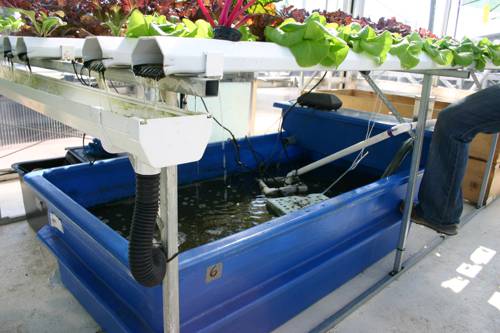
FAQ About Aquaponic Systems for Indoor Herbs

What is an aquaponic system and how does it work for indoor herbs?
An aquaponic system is a sustainable method of food production that combines aquaculture (raising fish) with hydroponics (growing plants without soil). In this system, fish waste provides an organic nutrient source for the plants, while the plants naturally filter and clean the water, which is then recirculated back to the fish tank. For indoor herbs, this system efficiently uses water and space, allowing for year-round cultivation of fresh herbs in a controlled environment.

What are the essential components of an indoor aquaponic system for herbs?
Key components of an indoor aquaponic system include a fish tank, grow bed, water pump, and a biofilter. The fish tank holds the fish, which produce waste that is converted by the biofilter into nutrients. The grow bed is the area where herbs are planted, and the water pump is necessary for circulating water between the tank and the grow bed. Additional components might include lighting for areas with insufficient natural light and a heater to maintain an optimal temperature for certain fish species.

Which herbs are best suited for aquaponic systems?
Many herbs thrive in aquaponic systems due to their relatively low nutrient requirements and fast growth rates. Popular choices include basil, mint, parsley, cilantro, and chives. These herbs benefit from the constant nutrient supply and moisture present in aquaponic setups and can be harvested continuously for kitchen use.

How do you balance the needs of fish and plants in an aquaponic system?
Balancing the needs of fish and plants in an aquaponic system involves maintaining appropriate water quality, pH levels, and nutrient concentrations. It's important to select fish species that produce waste suitable for the plants you want to grow. Regular monitoring of water conditions, such as ammonia, nitrite, and nitrate levels, is crucial, along with adjusting feeding rates and controlling plant density to ensure both fish and plants thrive.

What kind of fish are typically used in aquaponic systems?
Common fish species used in aquaponic systems include tilapia, goldfish, koi, and certain types of ornamental fish. These fish are chosen for their resilience, ability to produce a significant amount of waste suitable for plant nutrition, and ease of care. Tilapia is particularly popular due to its rapid growth rate and tolerance to a variety of water conditions.

How can you ensure proper light conditions for indoor herbs in aquaponics?
Ensuring proper light conditions involves using grow lights if natural sunlight exposure is insufficient. LED grow lights are effective for providing the spectrum of light that plants require for photosynthesis. It's important to position these lights at the right height and duration, typically 12-16 hours per day, to mimic natural daylight cycles and promote healthy plant growth.

What are the benefits of growing herbs with an indoor aquaponic system?
Growing herbs indoors using an aquaponic system offers numerous benefits, including reduced water usage compared to traditional soil gardening, efficient space utilization, and the ability to grow fresh herbs year-round. Additionally, aquaponics creates a symbiotic relationship between fish and plants, promoting healthy growth while minimizing environmental impact. The system also eliminates the need for synthetic fertilizers and pesticides.

How do you maintain water quality in an aquaponic system?
Maintaining water quality is crucial for the health of both fish and plants. Regular testing for pH levels, ammonia, nitrites, and nitrates is necessary. Ideally, the pH should be between 6.8 and 7.2, and ammonia and nitrites should be kept low. Regular water changes, careful monitoring of feeding, and ensuring a balanced density of fish and plants can help maintain optimal water conditions.

How often should you feed fish in an aquaponic system?
Feeding frequency depends on the type and age of the fish, but generally, fish in aquaponic systems should be fed once or twice a day. It is important to provide only the amount they can consume within a few minutes to prevent excess waste and maintain water quality. Overfeeding should be avoided as it can lead to water contamination, harming both fish and plant health.

Can you use an existing aquarium for an aquaponic system?
Yes, you can convert an existing aquarium into an aquaponic system by adding a grow bed, water pump, and necessary plumbing to circulate water between the fish tank and grow area. Ensure the aquarium is large enough to support both the fish and the chosen plants. Additionally, confirm that the structural setup can support the weight and ecosystem needs of the aquaponic system.

What type of grow bed media is recommended for aquaponic herbs?
Hydroton (expanded clay pebbles) is a popular choice for grow bed media in aquaponic systems due to its lightweight nature, good drainage, and excellent root support. Other options include gravel, perlite, or coconut coir. The choice of media should facilitate adequate water drainage and provide a stable environment for root growth while avoiding compaction.

How can pests be managed in an indoor aquaponic herb garden?
Managing pests in an indoor aquaponic system focuses on prevention and natural control methods. Regularly inspect plants for pests and use methods such as introducing beneficial insects (like ladybugs) or using neem oil sprays sparingly. Keeping the environment clean by removing debris and maintaining good water quality helps prevent pest infestations.

What temperature should be maintained for an aquaponic system?
The ideal temperature for an aquaponic system varies depending on the fish species. For most commonly used fish like tilapia, the water temperature should be kept between 22°C to 28°C (72°F to 82°F). Ensuring adequate room temperature that supports plant growth is also important, usually ranging between 18°C to 24°C (65°F to 75°F) for herbs.

How can pH levels affect an aquaponic system?
pH levels significantly impact nutrient availability to plants and the health of fish. A pH range of 6.8 to 7.2 is generally suitable for both processes. If the pH strays too far from this range, it can cause nutrient lockout in plants or stress and harm to fish. Regular monitoring and adjustments using pH buffers can help maintain the recommended range.

What are common challenges faced in maintaining aquaponic systems for herbs?
Common challenges include maintaining balanced water chemistry, dealing with fluctuations in pH, temperature, and nutrient levels, and managing pest outbreaks. Regular monitoring and system checks, along with proper planning and adjustments, help overcome these challenges. It's also important to choose compatible fish and plants and ensure they are suited to the environmental conditions of the system.

How much space is required for an indoor aquaponic system?
The space required depends on the scale of the system and the types of plants and fish you are growing. For a small-scale setup suitable for growing herbs, an area of about 4 to 6 square feet may be sufficient. Larger systems supporting more fish and a wider variety of plants will require more space, possibly requiring a dedicated room or larger area within a home.

Can aquaponic systems be made from recycled materials?
Yes, aquaponic systems can be creatively built using recycled materials, such as repurposed fish tanks, bathtubs, or plastic containers for grow beds. Using recycled materials can reduce the cost and environmental impact of setting up a system. However, ensure that any recycled material used is safe, non-toxic, and structurally sound to support the system components.

What role does aeration play in aquaponic systems?
Aeration is crucial in aquaponic systems as it ensures that both the fish and plant roots receive adequate oxygen. A proper level of dissolved oxygen in the water aids fish respiration and supports beneficial bacterial growth, which helps break down fish waste into plant nutrients. Air stones or additional aerating devices can enhance oxygen levels within the water system.

What is the typical startup time for an aquaponic system to stabilize?
Aquaponic systems generally take a few weeks to a couple of months to fully stabilize, depending on the initial setup and environmental conditions. During this time, beneficial bacteria must establish themselves in the biofilter to efficiently convert fish waste into nitrate, which the plants will use. It's crucial to monitor water parameters closely during this startup phase to avoid harming fish or plants.

How can you integrate automation in an aquaponic system for indoor herbs?
Automation can be integrated into an aquaponic system through the use of timers and sensors. Timers can manage lighting and water pumps, while sensors help monitor temperature, pH, and moisture levels. Automated feeders can regulate fish feeding, and automatic systems might also include alarms or notifications for deviations in water quality, ensuring a highly responsive and efficient setup.
